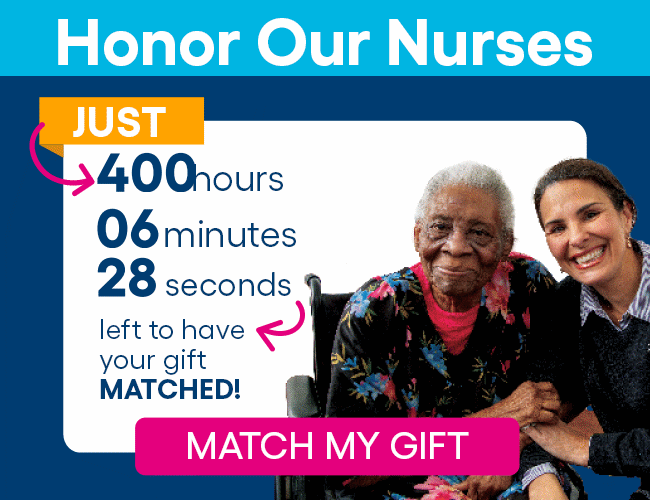VNS Health provides comprehensive hospice care to New Yorkers when they need it most. We believe that end-of-life services should be built on a foundation of compassion along with expert, high-quality care.
By referring your patient to VNS Health, you can know that they will be treated with dignity and compassion — every single day.
Refer a Patient to Hospice Care
VNS Health accepts hospice referrals from physicians, nurse practitioners, and physician assistants. Physicians must certify terminal illness.
Submit a referral online with our hospice e-referral form.
To refer a patient for hospice care by phone, call VNS Health Hospice Care at 1-212-609-1900.
Download our hospice referral form and fax to 1-212-290-1825.
In this 2-minute video, Dr. Erik Ilyayev shows how easy it is to refer your patients to VNS Health Hospice Care. He walks you through the online referral process, explains when the patient’s first visit will take place, and describes services available to your patients and their caregivers.
Hospice Eligibility Criteria
It can be difficult to know when a person’s illness has advanced to the point when hospice care is appropriate. As you get started, consider these three questions:
-
Would you be surprised if this patient lived longer than a year?*
-
Is the patient experiencing more frequent hospitalizations or ED visits?
-
Would a conversation about goals of care for the time remaining relieve anxiety or improve this patient’s quality of life?
If you answered “yes” to any of these questions, your patient may benefit from hospice care from VNS Health.
You can always contact VNS Health for guidance in determining eligibility. We can also assist with difficult conversations and in talking to patients and their families about goals of care.
*This is a helpful screening question used nationally. Actual eligibility for hospice requires a patient’s physician to certify terminal illness (life expectancy of 6 months or less).
In addition, patients with advanced illness who exhibit one or more of the following core and disease-specific indicators may be eligible for VNS Health Hospice Care.
Core Indicators For Hospice
- Karnofsky or Palliative Performance Scale (PPS) score < 70%
- Stage 3–4 pressure ulcers
- Serum albumin < 2.5 gm/dl
- Multiple hospitalizations
- Multiple comorbidities
- Physical decline
- Weight loss
- Infections
- Dependence on assistance for most ADLs
- Signs and symptoms such as increasing pain, dyspnea, nausea or vomiting, edema, pericardial/pleural effusion, ascites
Cardiology
- Increasing hospitalizations, office visits, or office calls
- Declining quality of life, including:
- Functional decline
- Shortness of breath or oxygen dependence at rest
- Extreme weakness or fatigue with recurrent chest pain
- Multiple comorbidities
- Continual changes in medications as treatment options diminish
- Growing need for home health assistance
COPD
- Increased hospitalizations, ED visits, office visits, or office calls
- Growing need for home health assistance
- Declining quality of life including:
- Dyspnea at rest or with minimal exertion
- Extreme weakness or fatigue
- Frequent bouts of bronchitis and/or pneumonia
- Increased anxiety and depression
- Continual changes in medications in attempts to stabilize condition
- Decreasing treatment options available to address symptoms
Dementia Due to Alzheimer’s Disease and Related Disorders
- Stage 7 or beyond according to the Functional Assessment Staging (FAST) scale, including:
- Unable to walk/dress/bathe without assistance
- Urinary and fecal incontinence
- No consistently meaningful verbal communication
- One of the following within the past 12 months
- Aspiration pneumonia, pyelonephritis, septicemia
- Multiple decubitus ulcers, stage 3–4
- Fever, recurrent after antibiotics
- Insufficient fluid and calorie intake
Oncology
- Drivers of complexity can include:
- High physical symptom burden (matched by complex treatments at home)
- High risk for hospitalization
- Psychosocial and spiritual needs
Heart Disease
- NYHA Class IV Heart Failure; angina
- Discomfort with physical activity
- Supporting factors:
- Ejection fraction ≤ 20%
- Arrhythmias resistant to treatment
- History of cardiac arrest or resuscitation
- Brain embolism of cardiac origin
- Concomitant HIV disease
Renal Disease: Acute Renal Failure/Chronic Kidney Disease
- No hemodialysis, no renal transplant
- In combination with at least one of the following:
- Creatinine clearance < 10 cc/min (<15 cc/min with diabetes or CHF; <20 cc/min with diabetes and CHF)
- Serum creatinine > 8.0 mg/dl (>6.0 mg/dl in diabetics)
- Signs and symptoms of uremia (confusion, nausea, pruritus, restlessness, pericarditis)
- Intractable fluid overload
- Oliguria
- Intractable hyperkalemia (>7.0 mmol/l)
- Glomerular filtration rate (GFR) < 10 ml/min
Liver Disease
- PT > 5 sec or INR > 1.5
- Serum albumin < 2.5 gm/dl
- In combination with at least one of the following complications:
- Ascites despite maximum diuretics
- Spontaneous bacterial peritonitis
- Hepatorenal syndrome
- Hepatic encephalopathy
- Recurrent variceal bleeding
